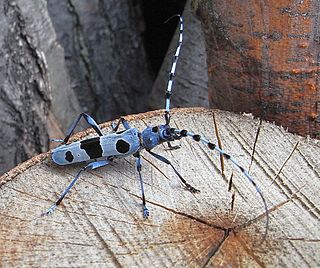 W
WAntennae, sometimes referred to as "feelers", are paired appendages used for sensing in arthropods.
 W
WArthropods, including insects and spiders, make use of smooth adhesive pads as well as hairy pads for climbing and locomotion along non-horizontal surfaces. Both types of pads in insects make use of liquid secretions and are considered 'wet'. Dry adhesive mechanisms primarily rely on van der Waals’ forces and are also used by organisms other than insects. The fluid provides capillary and viscous adhesion and appears to be present in all insect adhesive pads. Little is known about the chemical properties of the adhesive fluids and the ultrastructure of the fluid producing cells is currently not extensively studied. Additionally, both hairy and smooth types of adhesion have evolved separately numerous times in insects. Few comparative studies between the two types of adhesion mechanisms have been done and there is a lack of information regarding the forces that can be supported by these systems in insects. Additionally, tree frogs and some mammals such as the arboreal possum and bats also make use of smooth adhesive pads. The use of adhesive pads for locomotion across non-horizontal surfaces is a trait that evolved separately in different species, making it an example of convergent evolution. The power of adhesion allows these organisms to be able to climb on almost any substance.
 W
WThe mouthparts of arthropods have evolved into a number of forms, each adapted to a different style or mode of feeding. Most mouthparts represent modified, paired appendages, which in ancestral forms would have appeared more like legs than mouthparts. In general, arthropods have mouthparts for cutting, chewing, piercing, sucking, shredding, siphoning, and filtering. This article outlines the basic elements of four arthropod groups: insects, myriapods, crustaceans and chelicerates. Insects are used as the model, with the novel mouthparts of the other groups introduced in turn. Insects are not, however, the ancestral form of the other arthropods discussed here.
 W
WThe cephalothorax, also called prosoma in some groups, is a tagma of various arthropods, comprising the head and the thorax fused together, as distinct from the abdomen behind. The word cephalothorax is derived from the Greek words for head and thorax. This fusion of the head and thorax is seen in chelicerates and crustaceans; in other groups, such as the Hexapoda, the head remains free of the thorax. In horseshoe crabs and many crustaceans, a hard shell called the carapace covers the cephalothorax.
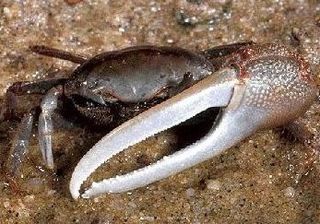 W
WA chela, also named claw, nipper, or pincer, is a pincer-like organ at the end of certain limbs of some arthropods. The name comes from Greek (χηλή) through New Latin. The plural form is chelae. Legs bearing a chela are called chelipeds. Another name is claw because most chelae are curved and have a sharp point like a claw.
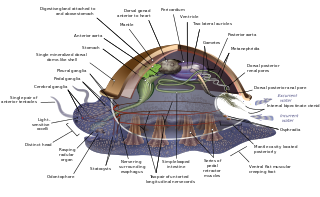 W
WA circumesophageal or circumpharyngeal nerve ring is an arrangement of nerve ganglia around the esophagus/ pharynx of an animal. It is a common feature of nematodes, molluscs, and many other invertebrate animals, though it is absent in all vertebrate animals and is not structurally possible in simpler ones such as water bears.
 W
WA compound eye is a visual organ found in arthropods such as insects and crustaceans. It may consist of thousands of ommatidia, which are tiny independent photoreception units that consist of a cornea, lens, and photoreceptor cells which distinguish brightness and color. The image perceived by this arthropod eye is a combination of inputs from the numerous ommatidia, which are oriented to point in slightly different directions. Compared with single-aperture eyes, compound eyes have poor image resolution; however, they possess a very large view angle and the ability to detect fast movement and, in some cases, the polarization of light.
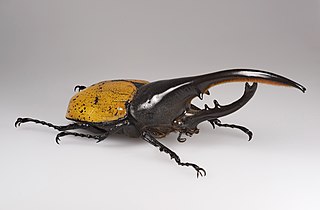 W
WThe cuticle forms the major part of the integument of the Arthropoda. It includes most of the material of the exoskeleton of the insects, Crustacea, Arachnida, and Myriapoda.
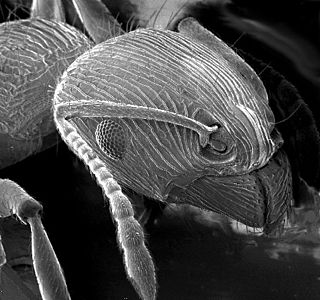 W
WArthropods are covered with a tough, resilient integument or exoskeleton of chitin. Generally the exoskeleton will have thickened areas in which the chitin is reinforced or stiffened by materials such as minerals or hardened proteins. This happens in parts of the body where there is a need for rigidity or elasticity. Typically the mineral crystals, mainly calcium carbonate, are deposited among the chitin and protein molecules in a process called biomineralization. The crystals and fibres interpenetrate and reinforce each other, the minerals supplying the hardness and resistance to compression, while the chitin supplies the tensile strength. Biomineralization occurs mainly in crustaceans; in insects and Arachnids the main reinforcing materials are various proteins hardened by linking the fibres in processes called sclerotisation and the hardened proteins are called sclerotin. Four sclerites form a ring around each segment: a dorsal tergite, lateral sternites and a ventral pleurite.
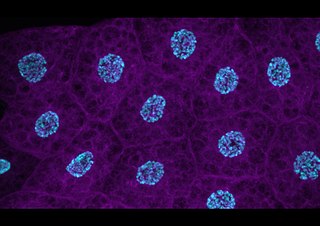 W
WFat body is a highly dynamic insect tissue composed primarily of storage cells. It is distributed throughout the insect's internal body cavity; the haemocoel, in close proximity to the epidermis, digestive organs and ovaries. Its main functions are nutrient storage and metabolism, for which it is commonly compared to a combination of adipose tissue and liver in mammals. However, it may also serve a variety of other roles, such as: endocrine regulation, systemic immunity, vitellogenesis, and housing of microbial symbionts.
 W
WA gill is a respiratory organ found in many aquatic organisms that extracts dissolved oxygen from water and excretes carbon dioxide. The gills of some species, such as hermit crabs, have adapted to allow respiration on land provided they are kept moist. The microscopic structure of a gill presents a large surface area to the external environment. Branchia is the zoologists' name for gills.
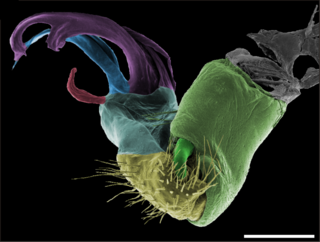 W
WGonopods are specialized appendages of various arthropods used in reproduction or egg-laying. In males, they facilitate the transfer of sperm from male to female during mating, and thus are a type of intromittent organ. In crustaceans and millipedes, gonopods are modified walking or swimming legs. Gonopods may be highly decorated with elaborate structures which may play roles in sperm competition, and can be used to differentiate and identify closely related species. Gonopods generally occur in one or more pairs, as opposed to the single (un-paired) reproductive organs such as the aedeagus of insects or the penis of harvestmen.
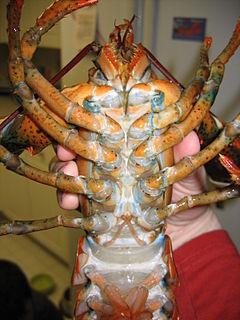 W
WA gonopore, sometimes called a gonadopore, is a genital pore in many invertebrates. Hexapods, including insects have a single common gonopore, except mayflies, which have a pair of gonopores. More specifically, in the unmodified female it is the opening of the common oviduct, and in the male, it is the opening of the ejaculatory duct.
 W
WGreat appendages are claw-like appendages which attach to the heads of the "great appendage arthropods", a name usually refers to Megacheira, a class of extinct arthropod characterized by a pair of "short-great appendages" bearing in front of the animal's head.
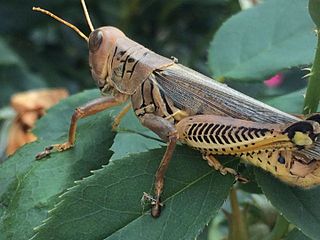 W
WHemolymph, or haemolymph, is a fluid, analogous to the blood in vertebrates, that circulates in the interior of the arthropod body remaining in direct contact with the animal's tissues. It is composed of a fluid plasma in which hemolymph cells called hemocytes are suspended. In addition to hemocytes, the plasma also contains many chemicals. It is the major tissue type of the open circulatory system characteristic of arthropods. In addition, some non-arthropods such as molluscs possess a hemolymphatic circulatory system.
 W
WThe hepatopancreas, digestive gland or midgut gland is an organ of the digestive tract of arthropods and molluscs. It provides the functions which in mammals are provided separately by the liver and pancreas, including the production of digestive enzymes, and absorption of digested food.
 W
WThe labrum is a flap-like structure that lies immediately in front of the mouth in almost all extant Euarthropoda. The most conspicuous exceptions are the Pycnogonida, which probably are chelicerate-relatives. In entomology, the labrum amounts to the "upper lip" of an insect mouth, the corresponding "lower lip" being the labium.
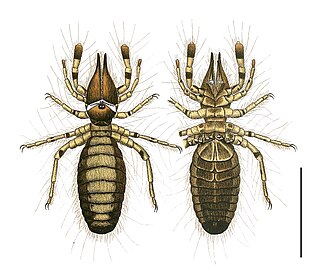 W
WMalleolus (plural: malleoli) is a fan-shaped chemoreceptor or Racquet Organ, an array of which are carried in pairs on the ventral or undersides of Solpugidae. They are the counterpart of pectines in scorpions, and modified walking limbs in the uropygids and amblypygids. Most species have 5 pairs of malleoli on the ventral surface of the fourth pair of legs of both sexes, while juveniles and other species have 2-3 pairs.In most animals the central pathways of olfactory systems are associated with glomerular neuropil and lack topographic mapping of sensory inputs. Among arthropods, the insect and crustacean olfactory (antennal) pathways are typical examples. Two orders of chelicerate arthropods, the scorpions and solpugids (Cl. Arachnida), present striking exceptions to this generalization. The major chemosensory organs of scorpions are the pectines, two ventral appendages that contact the substrate intermittently as the animal searches for food or mates. In solpugids chemosensory input is from the antennalized pedipalps and first leg pairs, and from ten fan-shaped malleoli extending ventrally to the substrate from the 4th leg pair. The pectinal and malleolar sensory systems have highly ordered arrangement of 105 to 106 primary chemoreceptors, with one (pectines) forming a two-dimensional array and the other (malleoli) assembled in a linear array. The spatial frequencies of these chemoreceptive inputs exceed 100/mm and 1000/mm, respectively, indicating a capacity for resolving structure of chemical deposits on substrates. Using several histological and axonal tracing techniques, the organization of pectinal and malleolar central projections has been resolved. The pectinal projection terminates posteriorly in the cephalothoracic mass and shows a high degree of topographic precision, perhaps to the level of individual receptors in the sensory field. This chemosensory 'map' is imposed on laminar cytoarchitecture posteriorly in the brain but merges anteriorly into glomerular substructures. The sensory projection from the malleoli shows less topographic order with fewer and larger glomeruli reminiscent of the insect olfactory system. These comparisons between arthropod taxa suggest that olfactory projections are, to varying degrees, typically glomerular but may evolve topographic and laminar organization when the stimulus field is of fixed form.
 W
WThe Malpighian tubule system is a type of excretory and osmoregulatory system found in some insects, myriapods, arachnids and tardigrades.
 W
WThe mandible of an arthropod is a pair of mouthparts used either for biting or cutting and holding food. Mandibles are often simply referred to as jaws. Mandibles are present in the extant subphyla Myriapoda, Crustacea and Hexapoda. These groups make up the clade Mandibulata, which is currently believed to be the sister group to the rest of arthropods, the clade Arachnomorpha.
 W
WIn arthropods, the maxillae are paired structures present on the head as mouthparts in members of the clade Mandibulata, used for tasting and manipulating food. Embryologically, the maxillae are derived from the 4th and 5th segment of the head and the maxillary palps; segmented appendages extending from the base of the maxilla represent the former leg of those respective segments. In most cases, two pairs of maxillae are present and in different arthropod groups the two pairs of maxillae have been variously modified. In crustaceans, the first pair are called maxillulae.
 W
WThe mesosoma is the middle part of the body, or tagma, of arthropods whose body is composed of three parts, the other two being the prosoma and the metasoma. It bears the legs, and, in the case of winged insects, the wings.
 W
WThe metasoma is the posterior part of the body, or tagma, of arthropods whose body is composed of three parts, the other two being the prosoma and the mesosoma. In insects, it contains most of the digestive tract, respiratory system, and circulatory system, and the apical segments are typically modified to form genitalia. In a few of the most primitive insects, the metasomal segments bear small, articulated appendages called "styli", which are often considered to be vestigial. There are also pre-apical appendages in most insect orders, called cerci, which may be multi-segmented and almost resembling a posterior pair of antennae; these may be variously modified, or lost entirely. Otherwise, most adult insects lack appendages on the metasoma, though many larval insects have some form of appendages, such as prolegs or, in aquatic insects, gills.
 W
WThe mushroom bodies or corpora pedunculata are a pair of structures in the brain of insects, other arthropods, and some annelids. They are also known to play a role in olfactory learning and memory. In most insects, the mushroom bodies and the lateral horn are the two higher brain regions that receive olfactory information from the antennal lobe via projection neurons. They were first identified and described by French biologist Félix Dujardin in 1850.
 W
WThe compound eyes of arthropods like insects, crustaceans and millipedes are composed of units called ommatidia. An ommatidium contains a cluster of photoreceptor cells surrounded by support cells and pigment cells. The outer part of the ommatidium is overlaid with a transparent cornea. Each ommatidium is innervated by one axon bundle and provides the brain with one picture element. The brain forms an image from these independent picture elements. The number of ommatidia in the eye depends upon the type of arthropod and range from as low as 5 as in the Antarctic isopod Glyptonotus antarcticus, or a handful in the primitive Zygentoma, to around 30,000 in larger Anisoptera dragonflies and some Sphingidae moths.
 W
WAn ozopore is the opening of a defensive gland present in some arthropods, notably in millipedes of the order Polydesmida and in harvestmen, the eight-legged arachnids also known as "daddy long-legs". The glands themselves are known as ozadenes, also called "scent glands", "repugnatorial glands", "odoriferous glands" or "stink glands" by various authors. The name is derived from Ancient Greek ozo "smell" and Latin porus "pore, small opening".
 W
WA pincer is the part of an arthropod that enables it to carry loads, to defend against other creatures, or to attack prey. In insects, the pincers are usually part of the creature's mandible, and often venom or acid can be injected through the pincer into an enemy during a pincer strike.
 W
WPleopodal lungs are an anatomical feature of terrestrial isopods and a component of their respiratory system. They are ancestrally derived from pleopodal gills, and they facilitate gas exchange on land. They perform a similar function as spiracles do in insects.
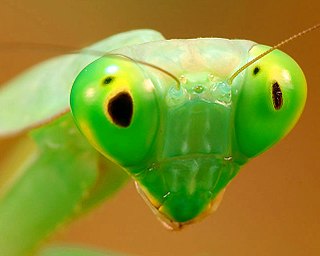 W
WIn the compound eye of invertebrates such as insects and crustaceans, the pseudopupil appears as a dark spot which moves across the eye as the animal is rotated. This occurs because the ommatidia that one observes "head-on" absorb the incident light, while those to one side reflect it. The pseudopupil therefore reveals which ommatidia are aligned with the axis along which the observer is viewing.
 W
WThe pygidium is the posterior body part or shield of crustaceans and some other arthropods, such as insects and the extinct trilobites. In groups other than insects, it contains the anus and, in females, the ovipositor. It is composed of fused body segments, sometimes with a tail, and separated from thoracic segments by an articulation.
 W
WA sclerite is a hardened body part. In various branches of biology the term is applied to various structures, but not as a rule to vertebrate anatomical features such as bones and teeth. Instead it refers most commonly to the hardened parts of arthropod exoskeletons and the internal spicules of invertebrates such as certain sponges and soft corals. In paleontology, a scleritome is the complete set of sclerites of an organism, often all that is known from fossil invertebrates.
 W
WA spiracle or stigma is the opening in the exoskeletons of insects and some more derived spiders to allow air to enter the trachea. In the respiratory system of insects, the tracheal tubes primarily deliver oxygen directly into the animals' tissues. The spiracles can be opened and closed in an efficient manner to reduce water loss. This is done by contracting closer muscles surrounding the spiracle. In order to open, the muscle relaxes. The closer muscle is controlled by the central nervous system, but can also react to localized chemical stimuli. Several aquatic insects have similar or alternative closing methods to prevent water from entering the trachea. The timing and duration of spiracle closures can affect the respiratory rates of the organism. Spiracles may also be surrounded by hairs to minimize bulk air movement around the opening, and thus minimize water loss.
 W
WThe statocyst is a balance sensory receptor present in some aquatic invertebrates, including molluscs, bivalves, cnidarians, ctenophorans, echinoderms, cephalopods, and crustaceans. A similar structure is also found in Xenoturbella. The statocyst consists of a sac-like structure containing a mineralised mass (statolith) and numerous innervated sensory hairs (setae). The statolith's inertia causes it to push against the setae when the animal accelerates. Deflection of setae by the statolith in response to gravity activates neurons, providing feedback to the animal on change in orientation and allowing balance to be maintained.
 W
WThe sternum is the ventral portion of a segment of an arthropod thorax or abdomen.
 W
WThe Stomatogastric Nervous System (STNS) is a commonly studied neural network composed of several ganglia in arthropods that controls the motion of the gut and foregut. The network of neurons acts as a central pattern generator. It is a model system for motor pattern generation because of the small number of cells, which are comparatively large and can be reliably identified. The system is composed of the stomatogastric ganglion (STG), oesophageal ganglion and the paired commissural ganglia.
 W
WThe subcapitulum, also known as infracapitulum, hypognathum or hipognatum, refers to the ventral part of the gnathosoma or the fusion of the palpal coxae and the labrum complex present in some arthropods on which the mouth, pedipalps, mouthparts and pharynx are generally located. It is delimited by the subcapitular apodeme, which separates it from the cheliceral frame.
 W
WThe telson is the posterior-most division of the body of an arthropod. It is not considered a true segment because it does not arise in the embryo from teloblast areas as do real segments. It never carries any appendages, but a forked "tail" called the caudal furca may be present. The shape and composition of the telson differs between arthropod groups.
 W
WA tergum is the dorsal ('upper') portion of an arthropod segment other than the head. The anterior edge is called the base and posterior edge is called the apex or margin. A given tergum may be divided into hardened plates or sclerites commonly referred to as tergites.
 W
WThe trachea, also called the windpipe, is a cartilaginous tube that connects the larynx to the bronchi of the lungs, allowing the passage of air, and so is present in almost all air-breathing animals with lungs. The trachea extends from the larynx and branches into the two primary bronchi. At the top of the trachea the cricoid cartilage attaches it to the larynx. The trachea is formed by a number of horseshoe-shaped rings, joined together vertically by ligaments over their substance and by the trachealis muscle at their ends. The epiglottis closes the opening to the larynx during swallowing.
 W
WTrichobothria are elongate setae ("hairs") present in arachnids, various orders of insects, and myriapods that function in the detection of airborne vibrations and currents, and electrical charge. In 1883, Friedrich Dahl observed that they were deflected by the sound waves from a violin and labelled them 'hearing hairs'.
 W
WThe ventral nerve cord (VNC) is a major structure of the invertebrate central nervous system. It is the functional equivalent of the vertebrate spinal cord. The VNC coordinates neural signaling from the brain to the body and vice versa, integrating sensory input and locomotor output Decapitated insects can still walk, groom, and mate, illustrating that the circuitry of the VNC is sufficient to perform complex motor programs without brain input.